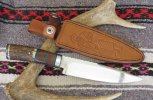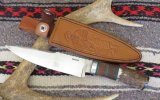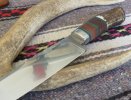Trubetzkoy
Basic Member
- Joined
- Jun 3, 2022
- Messages
- 424
It's hard to say based on pictures, since usually one sees only one side at a time. But based on the examples I've seen in person and the spine pictures I remember seeing online (usually showing the filework on the blade), I'd venture that the norm is for the false edge to be symmetric.I have spend the past 45 min searching for any info on criollo swedges with no much luck. One site in Spanish mentions that they ussually have one or two "contrafilos" (swedges) but that's all I found so far. I would think there is likely no standard regarding swedges. Abel Domenech does not mention them in his essay.
I do recall at least two knives being sold online which had the false edge, as well as the jimp-and-bevel work, ground only on one side of the blade – both 19th-century Sheffield pieces, interestingly. One is the Egroys & Co. I showed earlier in this thread:


The other is by Scholefield:


I suppose this was done when the blade wasn't very thick in the first place, much like in traditional British and American butcher knives.
Last edited:








